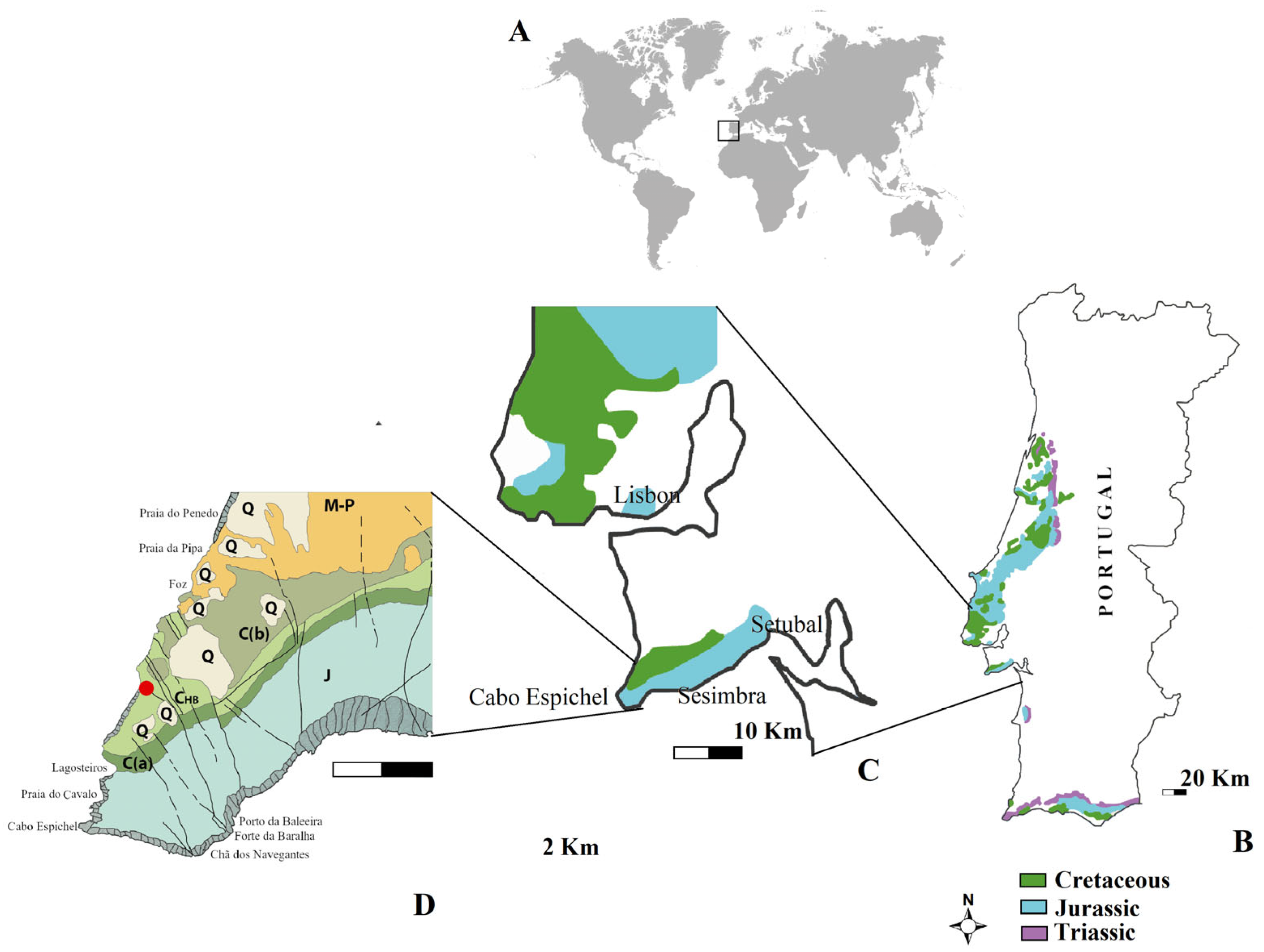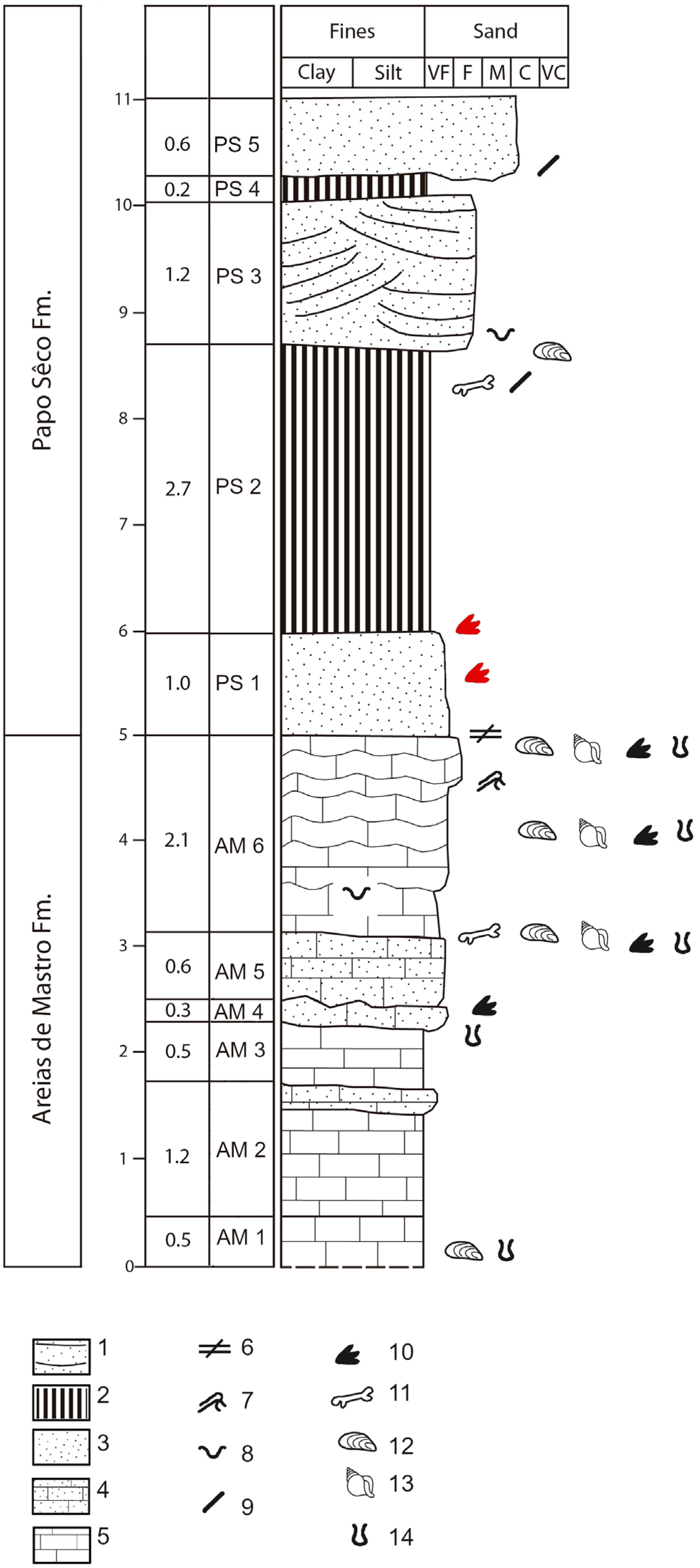Dinosaur Tracks of the Areia do Mastro and Papo-Seco Formations (Lower Cretaceous, Cabo Espichel): Paleobiological and Paleoenvironmental Continuities and Discontinuities †
Abstract
1. Introduction
2. Geological Settings
3. Materials and Methods
4. Results
5. Discussion
6. Conclusions
Funding
Data Availability Statement
Acknowledgments
Conflicts of Interest
References
- Antunes, M.T. Dinossáurios Eocretácicos de Lagosteiros. Ciências Terra 1976, 1, 1–35. [Google Scholar]
- Madeira, J.; Dias, R. Novas pistas de dinosáurios no Cretácico Inferior. Comun. Serviços Geológicos Port. 1983, 69, 147–158, (In Portuguese, with English abstract). [Google Scholar]
- Lockley, M.G.; Meyer, C.A.; dos Santos, V.F. Trackway evidence for a herd of juvenile sauropods from the Late Jurassic of Portugal. Gaia 1994, 10, 27–35. [Google Scholar]
- Ortega, F.; Escaso, F.; Gasulla, J.M.; Dantas, P.; Sanz, J.L. Dinosaurios de la Península Ibérica. Estud. Geológicos 2006, 62, 219–240, (In Spanish, with English abstract). [Google Scholar] [CrossRef]
- Santos, V.F. Pegadas de Dinossáurios de Portugal; Museu Nacional de História Natural: Lisboa, Portugal, 2008; 124p. [Google Scholar]
- Buffetaut, E.; Nori, L. Dinosaur remains from the “Sables Verts” (Early Cretaceous, Albian) of the Eastern Paris Basin. In Bernissart Dinosaurs and Early Cretaceous Terrestrial Ecosystems; Godefroit, P., Ed.; Indiana University Press: Bloomington, IN, USA, 2012; pp. 362–377. [Google Scholar]
- Santos, V.F.; Callapez, P.M.; Rodrigues, N.P.C. Dinosaur footprints from the Lower Cretaceous of the Algarve Basin (Portugal): New data on the ornithopod palaeoecology and palaeobiogeography of the Iberian Peninsula. Cretac. Res. 2013, 40, 158–169. [Google Scholar] [CrossRef]
- Santos, V.; Callapez, P.; Castanera, D.; Barroso-Barcenilla, F.; Rodrigues, N.; Cupeto, C. Dinosaur tracks from the Early Cretaceous (Albian) of Parede (Cascais, Portugal): New contributions for the sauropod palaeobiology of the Iberian Peninsula. J. Iber. Geol. 2015, 41, 155–166. [Google Scholar] [CrossRef]
- Díaz-Martínez, I.; Pereda-Suberbiola, X.; Pérez-Lorente, F.; Canudo, J.I. Ichnotaxonomic Review of Large Ornithopod Dinosaur Tracks: Temporal and Geographic Implications. PloS ONE 2015, 10, e0115477. [Google Scholar] [CrossRef]
- Figueiredo, S.D.; Rosina, P.; Figuti, L. Dinosaurs and other vertebrates from the Papo-Seco Formation (Lower Cretaceous) of southern Portugal. J. Iber Geol. 2015, 41, 301–314. [Google Scholar] [CrossRef]
- Figueiredo, S.D.; Dinis, P.; Belo, J.; Rosina, P.; Strantzali, I. A new record of a possible ornithopod footprint from the Lower Cretaceous of Cabo Espichel (Sesimbra, Portugal). Boll. Soc. Paleontol. Ital. 2017, 56, 217–231. [Google Scholar]
- Figueiredo, S.D.; de Carvalho, C.N.; Cunha, P.P.; de Sousa Carvalho, I. New Dinosaur Tracks from the Lower Barremian of Portugal (Areia do Mastro Formation, Cape Espichel). J. Geosci. Environ. Prot. 2021, 9, 84–96. [Google Scholar] [CrossRef]
- Figueiredo, S.D.; Carvalho, I.S.; Pereda-Suberbiola, X.; Cunha, P.P.; Antunes, V.; Diaz-Martínez, I. New ornithopod footprints from the Areia do Mastro Formation (Lower Cretaceous), Espichel Cape (Portugal, Western Iberia) and their context in the Iberian ichnological ornithopod record. Cretac. Res. 2022, 131, 105069. [Google Scholar] [CrossRef]
- Figueiredo, S.D.; Cunha, P.P.; Pereda-Suberbiola, X.; Neto de Carvalho, C.; Carvalho, I.S.; Buffetaut, E.; Tong, H.; Sousa, M.F.; Antunes, V.; Anastacio, R. The dinosaur tracksite from the lower Barremian of Areia do Mastro Formation (Cabo Espichel, Portugal): Implications for dinosaur behavior. Cretac. Res. 2022, 137, 105219. [Google Scholar] [CrossRef]
- Antunes, M.T.; Mateus, O. Dinosaurs of Portugal. Comptes Rendus Palevol 2003, 2, 77–95. [Google Scholar] [CrossRef]
- Sauvage, H.-E. Vertébres Fossils du Portugal. Contribuition à L’étude des Poisson et des Reptiles du Jurrassique et Crétacique; Direção dos Trabalhos Geológicos de Portugal: Lisboa, Portugal, 1897–1998; 1897–1898; 98p. Available online: https://docbase.lneg.pt/docs/AutoresVarios/4081.pdf?utm_source=chatgpt.com (accessed on 1 February 2025).
- Lapparent, A.F.; Zybszewski, G. Les Dinosauriens du Portugal. Mem. Ser. Geo. Portugal 1957, 2, 1–63. [Google Scholar]
- Buffetaut, E. The spinosaurid dinosaur Baryonyx (Saurischia, Theropoda) in the Early Cretaceous of Portugal. Geol. Mag. 2007, 144, 1021–1025. [Google Scholar] [CrossRef]
- Figueiredo, S. Breve Notícia sobre a Descoberta de um Novo Dinossáurio Ornitópode no Cabo Espichel. Bol. Centro Port. Geo-Hist. Pré-Hist. 2010, III, 7–15. [Google Scholar]
- Mateus, O.; Araúlo, R.; Natário, C.; Castanhinha, R. A new specimen of the theropod dinosaur Baryonyx from the early Cretaceous of Portugal and taxonomic validity of Suchosaurus. Zootaxa 2011, 2827, 54–68. [Google Scholar] [CrossRef]
- Figueiredo, S.; Strantzali, I.; Rosina, P.; Gomes, M. New Data about the Paleo Environment of the Papo-Seco Formation (Lower Cretaceous) of Southern Portugal. J. Environ. Sci. Eng. 2016, A5, 463–470. [Google Scholar] [CrossRef]
- Mateus, O.; Estraviz-López, D. A new theropod dinosaur from the early cretaceous (Barremian) of Cabo Espichel, Portugal: Implications for spinosaurid evolution. PLoS ONE 2022, 17, e0262614. [Google Scholar] [CrossRef] [PubMed]
- Figueiredo, S.D.; Marques, C.; Rosa, I.M.; Cunha, P.P.; de Souza Carvalho, I. Sauropod dinosaur remains from the Papo-Seco formation (lower Barremian, Lusitanian Basin, Cabo Espichel, Portugal): Previous and new discoveries. Cretac. Res. 2023, 151, 105657. [Google Scholar] [CrossRef]
- Figueiredo, S.D.; Souza Carvalho, I.; Pereda-Suberbiola, X.; Cunha, P.P.; Strantzali, I.B.; Antunes, V. Ornithopod dinosaur remains from the Papo-Seco Formation (lower Barremian, Lusitanian Basin, Portugal): A review of old and new finds. Hist. Biol. 2022, 35, 2181–2192. [Google Scholar] [CrossRef]
- Dantas, P.; Santos, V.F.; Lockley, M.G.; Meyer, C.A. Footprint evidence for limping dinosaurs from the Upper Jurassic of Portugal. Gaia 1994, 10, 43–48. [Google Scholar]
- Rey, J. Les unités lithostratigraphiques du Crétacé inférieur de la région de Lisbonne. Comun. Serviços Geológicos Port. 1992, 78, 103–124. [Google Scholar]
- Rey, J. Recherches Géologiques sur le Crétacé Inférieur de L’Estremadura (Portugal); Memória (Serviços Geológicos de Portugal): Lisboa, Portugal, 1972; Volume 21, 477p. [Google Scholar]
- Manupella, G.; Antunes, M.T.; Pais, J.; Ramalho, M.M.; Rey, J. Notícia Explicativa da Carta Geológica de Setúbal; Serviços Geológicos de Portugal: Lisboa, Portugal, 1999; 143p. [Google Scholar]
- Aillud, G.F. Palaeoecology, Palaeoenvironmental Analysis and Their Application to Sequence Stratigraphy: Lower Cretaceous, Lusitanian Basin. Ph.D. Thesis, University of Plymouth, Plymouth, UK, 2001. [Google Scholar]
- Dinis, J.; Rey, J.; Cunha, P.P.; Callapez, P.; Pena dos Reis, R. Stratigraphy and allogenic controls of the western Portugal Cretaceous: An updated synthesis. Cretac. Res. 2008, 29, 772–780. [Google Scholar] [CrossRef]
- Figueiredo, S.D.; Rosina, P.; Strantzali, I.; Antunes, V.; Figueiredo, S. Paleoenvironmental Changing Approach on the Lower Cretaceous Sequences of Areia do Mastro (Cabo Espichel, Southern Portugal). J. Environ. Sci. Eng. A 2020, 9, 66–71. [Google Scholar] [CrossRef]
- Thulborn, R.A. Dinosaur Tracks; Chapman and Hall: London, UK, 1990. [Google Scholar]
- Lockley, M.G.; Hunt, A.P. Dinosaur Tracks and Other Fossil Footprints of the Western United States; Columbia University Press: Cambridge, UK, 1995. [Google Scholar]
- Yang, X.-L.; Yang, D.-H. Dinosaur Footprints from the Mesozoic of the Sichuan Basin; Sichuan Science and Technology Publishing House: Chengdu, China, 1987; 30p, (In Chinese, with English abstract). [Google Scholar]
- Lockley, M.; Matsukawa, M.; Li, J. Crouching Theropods in Taxonomic Jungles: Ichnological and Ichnotaxonomic Investigations of Footprints with Metatarsal and Ischial Impressions. Ichnos 2003, 10, 169–177. [Google Scholar] [CrossRef]
- Lockley, M.G.; Jianjun, L.; Rihui, L.; Matsukawa, M.; Harris, J.D.; Lida, X. A Review of the Tetrapod Track Record in China, with Special Reference to Type Ichnospecies: Implications for Ichnotaxonomy and Paleobiology. Acta Geol. Sin. 2013, 87, 1–20. [Google Scholar] [CrossRef]
- Lockley, M. New perspectives on morphological variation in tridactyl footprints: Clues to widespread convergence in developmental dynamics. Geol. Q. 2009, 53, 415–432. [Google Scholar]
- Kullberg, J.C.; da Rocha, R.B.; Soares, A.F.; Duarte, L.V.; Marques, J.F. Palaeogeographical evolution of the Lusitanian Basin (Portugal) during the Jurassic. Part II: The slow-to-fast transformations of sedimentary infilling. In Proceedings of the STRATI 2013: First International Congress on Stratigraphy at the Cutting Edge of Stratigraphy, Lisbon, Portugal, 1–7 July 2013; Springer International Publishing: Cham, Switzerland, 2014; pp. 673–679. [Google Scholar]
- Avanzini, M.; Piñuela, L.; García-Ramos, J.C. Late Jurassic footprints reveal walking kinematics of theropod dinosaurs. Lethaia 2012, 45, 238–252. [Google Scholar] [CrossRef]
- Marty, D. Sedimentology, taphonomy, and ichnology of Late Jurassic dinosaur tracks from the Jura carbonate platform (Chevenez–Combe Ronde tracksite, NW Switzerland). GeoFocus 2008, 21, 1–278. [Google Scholar]
- Lockley, M.G. Tracking Dinosaurs: A New Look at an Ancient World; Cambridge University Press: Cambridge, UK, 1991. [Google Scholar]
- Myers, T.S.; Fiorillo, A.R. Evidence for gregarious behaviour and age segregation in sauropods. Palaeogeogr. Palaeoclimatol. Palaeoecol. 2009, 274, 96–104. [Google Scholar] [CrossRef]





Disclaimer/Publisher’s Note: The statements, opinions and data contained in all publications are solely those of the individual author(s) and contributor(s) and not of MDPI and/or the editor(s). MDPI and/or the editor(s) disclaim responsibility for any injury to people or property resulting from any ideas, methods, instructions or products referred to in the content. |
© 2025 by the author. Licensee MDPI, Basel, Switzerland. This article is an open access article distributed under the terms and conditions of the Creative Commons Attribution (CC BY) license (https://creativecommons.org/licenses/by/4.0/).
Share and Cite
Figueiredo, S.D. Dinosaur Tracks of the Areia do Mastro and Papo-Seco Formations (Lower Cretaceous, Cabo Espichel): Paleobiological and Paleoenvironmental Continuities and Discontinuities. Foss. Stud. 2025, 3, 18. https://doi.org/10.3390/fossils3040018
Figueiredo SD. Dinosaur Tracks of the Areia do Mastro and Papo-Seco Formations (Lower Cretaceous, Cabo Espichel): Paleobiological and Paleoenvironmental Continuities and Discontinuities. Fossil Studies. 2025; 3(4):18. https://doi.org/10.3390/fossils3040018
Chicago/Turabian StyleFigueiredo, Silvério Domingues. 2025. "Dinosaur Tracks of the Areia do Mastro and Papo-Seco Formations (Lower Cretaceous, Cabo Espichel): Paleobiological and Paleoenvironmental Continuities and Discontinuities" Fossil Studies 3, no. 4: 18. https://doi.org/10.3390/fossils3040018
APA StyleFigueiredo, S. D. (2025). Dinosaur Tracks of the Areia do Mastro and Papo-Seco Formations (Lower Cretaceous, Cabo Espichel): Paleobiological and Paleoenvironmental Continuities and Discontinuities. Fossil Studies, 3(4), 18. https://doi.org/10.3390/fossils3040018





